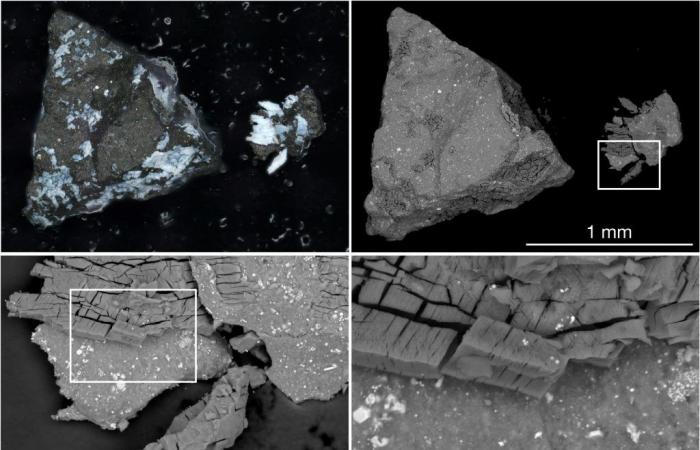Microscopic details of a sample of material from the asteroid Bennu, recovered by the Osiris-Rex mission. The top left panel shows a dark particle about a millimeter across from Bennu’s surface material, which has an outer crust of glowing phosphate. The other three panels show progressively magnified views of a fragment of the particle that broke off along a glowing fracture containing phosphate, imaged by scanning electron microscopy. Credit: NASA
The first results of the analysis of the rock sample from the asteroid (101955) Bennu, collected and brought back to Earth last fall by NASA’s Osiris-Rex (Origins, Spectral Interpretation, Resource Identification, and Security-Regolith Explorer) mission, are in. The study was conducted by an international research team that includes researchers from the National Institute for Astrophysics (INAF) with the support of the Italian Space Agency (ASI). The grains analyzed, both from a morphological and chemical point of view, contain the primordial constituents from which the Solar System was formed. The asteroid dust is rich in carbon and nitrogen, as well as organic compounds, all essential components for life as we know it. The sample studied also contains magnesium-sodium phosphate, a surprise for the research team, since this compound had not been detected by the remote sensing instruments collected by the probe in the vicinity of Bennu. The presence of magnesium-sodium suggests that the asteroid may have formed in a water-rich environment.
«Thanks to the analysis of high-resolution images of the samples we counted 7154 grains», they comment Maurizio Pajola e Philip Tusbertiboth researchers at the INAF in Padua who participated in the analyses, published yesterday on Meteoritics & Planetary Science. «Of these, 95 percent are larger than 0.5 mm, 34 grains are larger than 1 cm, and the largest was found to be 3.5 cm. The full count of all particles is currently still underway given the huge number brought back to earth. In particular, obtaining the size distribution of all the grains is of fundamental importance to understand whether it reflects that obtained remotely, when we orbited Bennu, or whether there were alterations (disintegrations) during the sampling process and/or re-entry into the atmosphere. terrestrial. Furthermore, identifying the larger sizes immediately helped the team decide which grains to work on from the beginning.”
Chemical investigations of the Bennu sample revealed interesting information about the asteroid’s composition. Dominated by clay minerals, particularly serpentine, the sample reflects the type of rock found on Earth’s mid-ocean ridges, where mantle material – the layer immediately beneath the Earth’s crust – meets water. This interaction not only results in the formation of clay, but also gives rise to a variety of minerals such as carbonates, iron oxides and iron sulfides. But the most unexpected discovery from these first investigations is the presence of water-soluble phosphates, which are the “building blocks” of life known on Earth today.
Phosphates were also found in the grains of the asteroid Ryugu brought back to Earth by the Hayabusa2 mission of the Jaxa (Japan Aerospace Exploration Agency) in 2020. The magnesium-sodium phosphate detected in the Bennu sample stands out for the lack of inclusions in the mineral and for the size of its grains, unprecedented in any meteorite sample.
The finding of magnesium-sodium phosphates in the Bennu sample raises questions about the geochemical processes that concentrated these elements and provides valuable clues to Bennu’s formative conditions.
“The presence and state of phosphates, along with other elements and compounds on Bennu, suggest the presence of water in the asteroid’s history,” explains Dante Lauretta of the University of Arizona in Tucson, lead author of the paper and the scientific director of the Osiris-Rex mission. “Bennu could potentially have been part of a wetter world. However, this hypothesis requires further investigation.”
Despite its possible history of interaction with water, Bennu remains a chemically primitive asteroid, with abundances of chemical elements very similar to those detected in the Sun.
“The sample we returned is the largest amount of unaltered asteroid material on Earth at this time,” adds Lauretta.
This composition offers a glimpse into the early days of the Solar System, more than 4.5 billion years ago. These rocks have remained in their original state, having neither melted nor resolidified since their formation, preserving valuable information about their origins to this day. The team also confirmed that the asteroid is rich in carbon and nitrogen. These elements are crucial to understanding the environments in which Bennu’s constituents arose and the chemical processes that transformed simple elements into complex molecules, potentially laying the foundation for life on Earth.
«Contrary to what happens with meteorites, the missions of sample return like Osiris-Rex, they allow us to study material taken directly from the surface of planetary objects and therefore to contextualise with great precision the results of the analyses carried out on these grains in laboratories spread throughout the world”, says Eleonora Ammannito, researcher at ASI. «It is precisely this characteristic that allowed us to immediately make the connection between the presence of phosphates in Bennu grains with the properties that our planetary system had at the time of its formation. Further analysis and comparison with what was found in the grains taken from Ryugu, an asteroid very similar to Bennu, will provide valuable information to better understand the processes of planetary evolution.”
In the coming months, many laboratories in the United States and around the world will receive material from the asteroid Bennu, currently stored at NASA’s Johnson Space Center in Houston. This will allow for the multiplication of investigations and therefore of scientific articles that will result, allowing for the study in ever greater detail of their properties and reconstructing the history of the asteroid and the Solar System.
To know more:
- Read on Meteoritics & Planetary Science l’articolo “Asteroid (101955) Bennu in the laboratory: Properties of the sample collected by OSIRIS-REx”, di Dante S. Lauretta, Harold C. Connolly Jr, Joseph E. Aebersold, Conel M. O’D. Alexander, Ronald-L. Ballouz, Jessica J. Barnes, Helena C. Bates, Carina A. Bennett, Laurinne Blanche, Erika H. Blumenfeld, Simon J. Clemett, George D. Cody, Daniella N. DellaGiustina, Jason P. Dworkin, Scott A. Eckley, Dionysis I. Foustoukos, Ian A. Franchi, Daniel P. Glavin, Richard C. Greenwood, Pierre Haenecour, Victoria E. Hamilton, Dolores H. Hill, Takahiro Hiroi, Kana Ishimaru, Fred Jourdan, Hannah H. Kaplan, Lindsay P. Keller, Ashley J. King, Piers Koefoed, Melissa K. Kontogiannis, Loan Le, Robert J. Macke, Timothy J. McCoy, Ralph E. Milliken, Jens Najorka, Ann N. Nguyen, Maurizio Pajola, Anjani T. Polit, Kevin Righter, Heather L. Roper, Sara S. Russell, Andrew J. Ryan, Scott A. Sandford, Paul F. Schofield, Cody D. Schultz, Laura B. Seifert, Shogo Tachibana, Kathie L. Thomas-Keprta, Michelle S. Thompson, Valerie Tu, Filippo Tusberti, Kun Wang, Thomas J. Zega, C. W. V. Wolner, the OSIRIS-REx Sample Analysis Team






